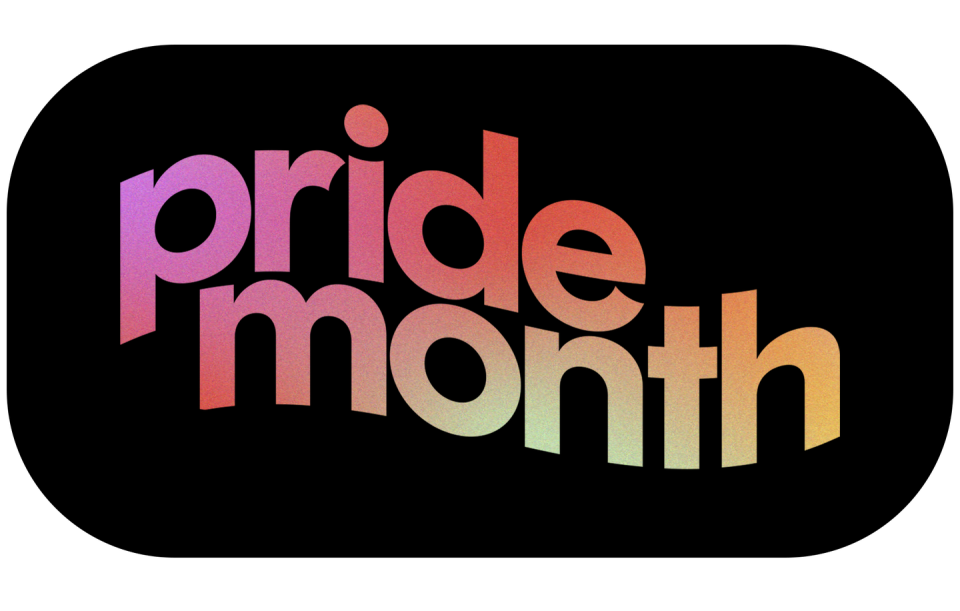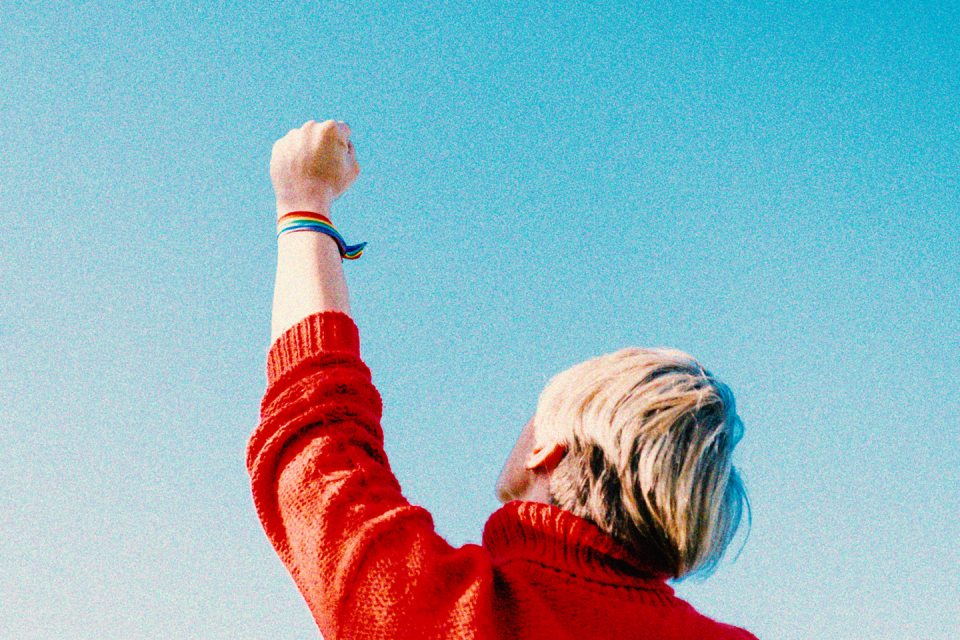A Love Letter to Being “All Butchy”
- Oops!Something went wrong.Please try again later.
When I was 15 years old, I told my mom I liked girls and she said she loved me no matter what. Then she said, “Just don’t be all butchy.” We laughed. Of course I wouldn’t be that.
The bumbling, androgynous character “Pat” first appeared on Saturday Night Live the year I was born, 1990. I grew up watching my parents chuckle as SNL performers asked Pat leading questions to determine Pat’s gender, to no avail. I laughed along with them. My family knew Pat was “really” a woman—SNL cast member Julia Sweeney concealed her breasts, donned a button-up shirt and ill-fitting khakis, and stuffed her hair under a short, curly wig to play the snickering, socially awkward role. What do you call a short-haired woman in menswear? Most people would probably say “butch,” and from an early age, I knew that butch was something I could not and should not be.

Before “butch,” there were words like “bull dagger” and “bull dyke,” which originated in Black lesbian culture in 1920s Harlem. In the 1940s, “butch,” which had previously been used to describe tough or physically fit men, evolved into a disparaging term for “manly” women. Working-class lesbians who wore men’s clothing claimed the descriptor with pride.
That pride was mostly confined to gay bars, but butches weren’t always safe there. McCarthyism ushered in a heightened moral panic around homosexuality, and police raids of gay bars became increasingly common throughout the ’50s and ’60s. Thanks to archaic masquerade laws, butches, transgender women, and other gender non-conforming patrons were often beaten and arrested for “cross-dressing.”
Straight people weren’t the only ones who vilified gender non-conforming people. Well into the ’70s, some lesbian activists vocally distanced themselves from butches, presenting themselves as “normal,” respectable taxpayers so they could better integrate into straight culture. One newsletter for the lesbian organization Daughters of Bilitis published a letter to the editors in the ’50s that read, “The kids in fly front pants and with butch haircuts and mannish manner are the worst publicity that we can get.”
To recap, female masculinity has long been associated with ugliness and failure, but growing up, I was neither of those things. A high achiever with long, wavy hair, I excelled in school, theater, and dance. I also knew I liked girls as soon as I learned what a lesbian was. After coming out, I experienced homophobia from some relatives, peers, my friends’ parents, and my high school principal, but I didn’t feel ashamed—I felt angry.
Still, I didn’t want to give those bullies any more fuel, so I wasn’t “all butchy,” at least not at first. In high school, I wore meticulous liquid eyeliner and huge dangling earrings. I grew my hair down to my waist. Today, I know many queer women who embrace this aesthetic with ease. During my brief femme era, I felt attractive, sort of, but I didn’t feel like myself. From early childhood, I had always been drawn to a more masculine expression. But when I went to college—a place where I was determined to have all the gay sex I’d missed out on in high school—I turned the femme drag up a notch. I believed that in order to be desired, I had to look desirable, and as far as I knew, there was only one way to do that.
Growing up in a relatively conservative town, I hadn’t seen many representations of gender non-conforming people, and the ones I saw on TV—like SNL’s Pat—were mostly presented in a negative light. Even The L Word, a Showtime lesbian drama I’d illegally downloaded on Limewire, offered minimal representation of masculine women, and the series gave its only trans character a storyline filled with misconceptions.
Things changed a few weeks into college, when I finally started meeting masc cis women, genderqueer folks, trans women, and trans men, and their existence and encouragement opened up new possibilities for my own gender expression. I cut my hair. I started buying clothes in the men’s section. (Well, more often in the boys’ section—I’m 5'2".) I had a regrettable love affair with fedoras. I felt comfortable, and in my queer social bubble, I was surrounded by people who were comfortable around me.
Throughout my late teens and 20s, I tried out a series of different gender identifiers—genderqueer, trans, non-binary, masc. I’ve used she/her pronouns, then he/him, then they/them. In recent years, I’ve stopped using any particular words to describe my gender, but sometimes I find myself drawn to “butch” because of its connection to queer history and the image it conjures.
No matter how I’ve defined myself throughout my adult life, my gender presentation has remained pretty much the same. For well over a decade, I’ve maintained a near-daily uniform of a black shirt, black jeans, black boots, and a short haircut, and my appearance has determined how I’m treated in the world. In an era when horrific anti-trans legislation is targeting trans children and trans women, I’m extremely privileged. I rarely feel unsafe—but I often feel uneasy.

I wasn’t allowed to use my own college library for months because I “didn’t look like my school ID” after cutting my hair. I’ve been confronted in women’s locker rooms. Patrons and security guards have kicked me out of the women’s bathroom at my own workplace, at a family member’s wedding, and even at my local LGBTQ+ center. About 50 percent of the time, strangers read me as a young boy rather than a 32-year-old adult, which can lead to awkward and sometimes scary encounters. On one of many occasions when I was stopped by the TSA, an agent demanded to know what was “strapped to my chest.” “My boobs,” I said. “I’m wearing a bra.” Strangers regularly ask me what my gender is or ask leading questions to reveal my “true” identity. My life is a never-ending “It’s Pat!” sketch, and it’s only funny sometimes.
It’s been hard to find pride and power in my gender expression when it’s so often a point of confusion, and since I’ve been called “ugly” (to my face, sometimes by people I love) so many times in response to my masculinity, I’ve struggled to see myself as an attractive person. And I’m saying this as a thin, white person who otherwise fits socially accepted body norms! If I struggle to feel beautiful—er, rather, handsome, then I cannot imagine how hard it must be for gender non-conforming folks who don’t have access to those privileges.
In my 30s, I’ve been working to change my self-image by filling my life and social media feeds with images of masc dykes, which is much easier now than it was during my teen years. I follow butches on Instagram and read Butch Is Not a Dirty Word, a magazine and Instagram account dedicated to butches and those who love them. I’m developing friendships with gender non-conforming, queer mentors who are decades older than I am. I’ve also been watching Work in Progress, a comedy series featuring a butch protagonist who actually confronts Julia Sweeney herself about her “Pat” SNL character in the first episode.
Those of us who don’t fit cultural gender norms have to seek out our own affirmation, and for some of us, feeling pride in our gender expression might be a process. As a queer writer, I’m trying to create media that helps other gender non-conforming people feel confident in their expression, and I’m always seeking media by other creators that speaks to my own experience. I’m not going to stop being “all butchy”—I don’t think I could if I tried—so I might as well learn how to feel at home within myself.
You Might Also Like

